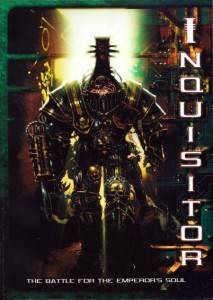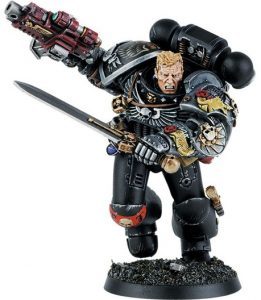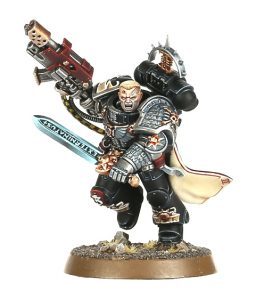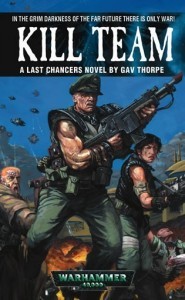A Brief History of the Deathwatch
Original Brother Artemis Mini
Or, how I made up a thing 16 years ago and now amazingly it’s currently the hottest trend in 40K.There’s a lot of talk about the Deathwatch at the moment in the Warhammer 40,000 community, with the recent releases of two boxed games and an army, as well as accompanying short stories and novels. It’s not often that I spend time contemplating the contributions I’ve made to Warhammer and 40K over the years, but the scale of the evolution and elevation of the Deathwatch has prompted me to reflect on their pragmatic beginnings.
We Need A Big Space Marine
Back in the heady days of 1999 I was working on Inquisitor – Battle for the Emperor’s Soul. In the early stages of development I sat down and started working on a proposal for the miniatures ranges that would be attached to the game. The range would be relatively small at just 15 codes, and because of that the characters we chose would have to represent not only strong archetypes and images but also be flexible in their application, capable of serving alongside each other in different types of warrior bands.
It was decided from the outset that there would be a space marine included. The main thrust of Inquisitor was to present a range of 54mm miniatures for modellers and painters and it would be lunacy not to include one of Warhammer 40,000’s flagship warriors. Given the level of detail on the model it would be better if we did not single out one Chapter to represent but gave collectors the option of painting a warrior from any Chapter.
On the other hand, the background for the game and rules were clearly moving toward a more covert, roleplay-centric approach. Not ideal ground for power armoured holy warriors intended to rampage across the bloody battlefields of the galaxy.
 It was also obvious that a space marine would be of a power level equal to if not greater than a typical Inquisitor in game terms (or a Chaos Magus, as was also initially envisaged, though that’s a whole other post…) and therefore the space marine character would also have to be someone that could potentially substitute as a leader of a warrior band to keep the power level of the game from escalating.
It was also obvious that a space marine would be of a power level equal to if not greater than a typical Inquisitor in game terms (or a Chaos Magus, as was also initially envisaged, though that’s a whole other post…) and therefore the space marine character would also have to be someone that could potentially substitute as a leader of a warrior band to keep the power level of the game from escalating.
So that became the brief – a space marine that could equally lead an Inquisitorial warband, or operate alongside an Inquisitor, of no particular Chapter.
Aside – back in my days on White Dwarf I had a similar task with Ian Pickstock, to come up with a promotional non-Chapter space marine character, I think for the Apocalypse 100 retail event (although that might have been when we created Centurius, it all blurs). From that simple brief came the Emperor’s Champion, the legend of Sigismund and all else that has followed! From small acorns and all that.
The Alien Hunters
It so happened that roughly at the same time, work had begun on what would become Codex: Armageddon, detailing the battles and forces of the Third Armageddon War. As part of the book I concocted a list of participating forces – names of Chapters, Titan Legions, Imperial Guard regiments. I threw in a few exotic references, including, if I remember correctly, ‘Six Ordo Xenos kill-teams’.
The alien hunters of the Ordo Xenos persuasion had long been under-represented in 40K. The Realm of Chaos books and Grey Knights had fleshed out a lot of the daemon-hunting Ordo Malleus, and some of the work I did on Sisters of Battle and later developments intended for Codex: Witch Hunters added meat to the bones of the Ordo Hereticus.
There seemed a gap wanting to be filled…
New Brother Artemis Mini
Arise, Captain of the DeathwatchMy original idea for the Deathwatch was to portray something different to the Grey Knights (a Chamber Militant of the Inquisition) and the Sisters of Battle (a convenient affiliation). My concept was not for a single organisation like a Space Marine Chapter but a series of historical arrangements between many space marine Chapters and agents of the Ordo Xenos, codified but not rationalised.
I wish I still had my original notes but they have been lost to antiquity, but they went along the lines of:
Who guards the Gates of Varl against the quiescent perils of the C’tan? Who stands ready to combat the menace of the Behemoth and the Kraken? Who patrols the endless night of the Halo Stars?
The Deathwatch!
A single brother of the Deathwatch could be dispatched on a particular mission, calling upon those ancient agreements. He might spend years or decades on that duty until relieved or killed, perhaps never heard from again. Or he might be sent into the depths of a hive world to root out a genestealer cult (the enemy within de jour) or to cleanse a hrud infestation. Over the course of that duty the Deathwatch warrior might, like an Inquisitor, accumulate necessary companions…
Jes Goodwin created the first Deathwatch warrior, of which he has spoken about in the pages of White Dwarf and art books. For my part, the job then became turning the concept into a character. Every miniature in the Inquisitor range is an individual, and while they might be used to represent a wider type, each had their own name and backstory.
With Brother-Captain Artemis I wanted to demonstrate that the space marines of the Deathwatch are chosen not just for their lethality, that they are more than just a space marine with specialist equipment. The warriors of the Deathwatch are possessed of a desire to understand their enemies, the better to slay them. Like the Inquisition they must be ready to embrace the unexpected and unorthodox, with initiative and flexibility rather than dogma and doctrine.
It is these traits that best distinguish the Deathwatch from a space marine chapter – they adhere to no ‘cult’ other than that which they bring with them from their Chapter, but the Ordo Xenos provides a unique, sometimes pro-active modus operandi. Tasked to a singular mission, the Deathwatch can put aside all other considerations of duty until the enemy is slain, the threat contained.
A lot of the Deathwatch background was expanded in the roleplay game of the same name by Fantasy Flight, until we come up to the present day and the recent releases from Games Workshop, fleshing out the ideas into a full army (which, if I’m honest, I am in two minds about, given the original concept as an organisation of small teams and solitary warriors).
The first appearance of a Deathwatch Space Marine in Black Library fiction is older than many people realise – being in my appropriately named Last Chancers novel, Kill Team. I then returned to them, and Brother-Captain Artemis in particular, with the audio drama Mission: Purge and the short story Mission: Annihilate
In the last year and more, a number of short stories and novellas have entered the world, with the most prominent recent additions to the Black Library lore of the Deathwatch coming from the likes of Robbie MacNiven, and Ian St Martin – who was nice enough to ask me for a bit more detail on the warriors featured in the Mission: X stories for a forthcoming work. I shared my character bios with him, and it seems fitting that I share them with you now…
(Not all of them ended up like this in the story, but you get the idea about the range of characters the Deathwatch can provide.)
Brother-captain Artemis Mortifactors Chapter. A warrior that personifies the Imperial adage ‘Only in death does duty end.’ Absolutely will not give up until the genestealers have been eradicated and never once gives thought to defeat. A veteran of many campaigns, he considers it an honour to be serving in the Deathwatch.
Haryk Thunderfang: Space Wolves Chapter. A pragmatic warrior, Haryk is adaptable and steadfast, adjusting to the ever-changing situation with calm aplomb. He is vocal with his opinions but wholeheartedly backs whatever plan is agreed when the decision has been made. He serves with the Deathwatch as a matter of fulfilling the Chapter’s oath and considers it his duty even if he would rather be with his Great Company.
Brother Neremis: Red Talons Chapter. Taciturn to the point of anti-social, Neremis is a reluctant member of the kill team, having been chosen by lot to represent his Chapter’s obligation. He is the most technically-minded of the squad, acting as armourer, his skills outweighing his truculent nature.
Brother Urbino: A Black Shield. As a Black Shield, Urbino’s origins are kept secret. He has severed ties with his former Chapter and serves only the Deathwatch now. [[If you want to know more about Brother Urbino, and have listened to Mission: Purge, click through here to my spoilers page. Everyone else, be warned – spoilers!]]
Brother Lavestus: White Consuls Chapter. The born-again space marine, devoted to the Emperor as a god. Basically, what if one of the guys in the team was an evangelical Christian and kept trying to convince his mates to join him? That’s this dude. A deadly, righteous warrior who feels that being sent to the Deathwatch is somehow an opportunity to be a missionary for his Chapter’s beliefs.
Brother Sekor: Imperial Castellans Chapter. Young and head-strong, Sekor is not long out of his Chapter’s Scout company and has been dispatched to the Deathwatch for some undisclosed misdemeanour. Seeing his term with the alien hunters as a punishment, and only temporary, Sekor borders on insubordinate, claiming that Artemis and the others have no true authority over him. This will get him killed. Oh well.
If you’re interested in reading more about my involvement with Inquisitor, head over to my Games Page.
**To make sure you don’t miss out on any blog posts, you can keep up-to-date with everything Gav by signing up to my monthly newsletter. As a bonus, every other month I randomly pick a newsletter subscriber to receive a free signed copy of one of my books. The next competition is for a copy of my Horus Heresy Audio, The Thirteenth Wolf.**
Please Feel Free to Share:







 newest »
newest »
 Did the Legion of the Damned have similar origins?
Did the Legion of the Damned have similar origins?







